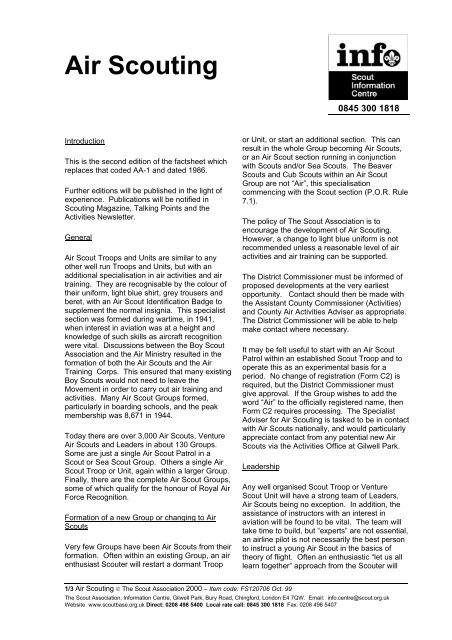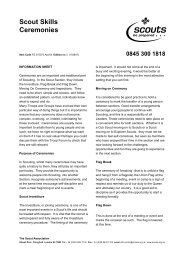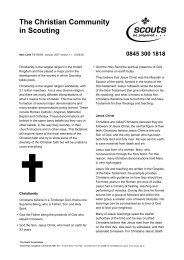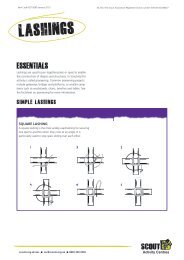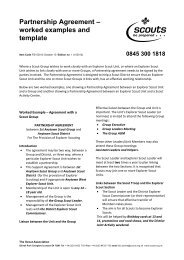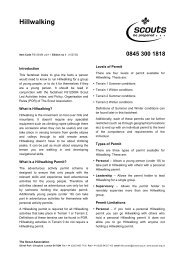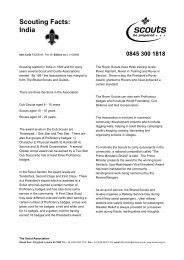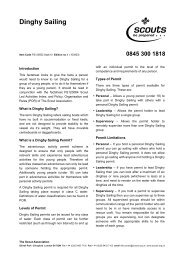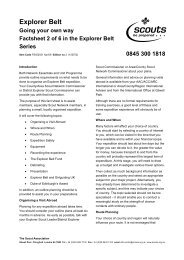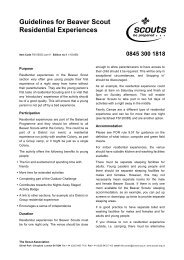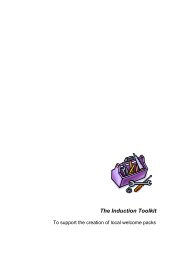Air Scouting - ScoutBase UK
Air Scouting - ScoutBase UK
Air Scouting - ScoutBase UK
Create successful ePaper yourself
Turn your PDF publications into a flip-book with our unique Google optimized e-Paper software.
<strong>Air</strong> <strong>Scouting</strong><br />
Introduction<br />
This is the second edition of the factsheet which<br />
replaces that coded AA-1 and dated 1986.<br />
Further editions will be published in the light of<br />
experience. Publications will be notified in<br />
<strong>Scouting</strong> Magazine, Talking Points and the<br />
Activities Newsletter.<br />
General<br />
<strong>Air</strong> Scout Troops and Units are similar to any<br />
other well run Troops and Units, but with an<br />
additional specialisation in air activities and air<br />
training. They are recognisable by the colour of<br />
their uniform, light blue shirt, grey trousers and<br />
beret, with an <strong>Air</strong> Scout Identification Badge to<br />
supplement the normal insignia. This specialist<br />
section was formed during wartime, in 1941,<br />
when interest in aviation was at a height and<br />
knowledge of such skills as aircraft recognition<br />
were vital. Discussions between the Boy Scout<br />
Association and the <strong>Air</strong> Ministry resulted in the<br />
formation of both the <strong>Air</strong> Scouts and the <strong>Air</strong><br />
Training Corps. This ensured that many existing<br />
Boy Scouts would not need to leave the<br />
Movement in order to carry out air training and<br />
activities. Many <strong>Air</strong> Scout Groups formed,<br />
particularly in boarding schools, and the peak<br />
membership was 8,671 in 1944.<br />
Today there are over 3,000 <strong>Air</strong> Scouts, Venture<br />
<strong>Air</strong> Scouts and Leaders in about 130 Groups.<br />
Some are just a single <strong>Air</strong> Scout Patrol in a<br />
Scout or Sea Scout Group. Others a single <strong>Air</strong><br />
Scout Troop or Unit, again within a larger Group.<br />
Finally, there are the complete <strong>Air</strong> Scout Groups,<br />
some of which qualify for the honour of Royal <strong>Air</strong><br />
Force Recognition.<br />
Formation of a new Group or changing to <strong>Air</strong><br />
Scouts<br />
Very few Groups have been <strong>Air</strong> Scouts from their<br />
formation. Often within an existing Group, an air<br />
enthusiast Scouter will restart a dormant Troop<br />
1/3 <strong>Air</strong> <strong>Scouting</strong> © The Scout Association 2000 – Item code: FS120706 Oct. 99<br />
0845 300 1818<br />
or Unit, or start an additional section. This can<br />
result in the whole Group becoming <strong>Air</strong> Scouts,<br />
or an <strong>Air</strong> Scout section running in conjunction<br />
with Scouts and/or Sea Scouts. The Beaver<br />
Scouts and Cub Scouts within an <strong>Air</strong> Scout<br />
Group are not “<strong>Air</strong>”, this specialisation<br />
commencing with the Scout section (P.O.R. Rule<br />
7.1).<br />
The policy of The Scout Association is to<br />
encourage the development of <strong>Air</strong> <strong>Scouting</strong>.<br />
However, a change to light blue uniform is not<br />
recommended unless a reasonable level of air<br />
activities and air training can be supported.<br />
The District Commissioner must be informed of<br />
proposed developments at the very earliest<br />
opportunity. Contact should then be made with<br />
the Assistant County Commissioner (Activities)<br />
and County <strong>Air</strong> Activities Adviser as appropriate.<br />
The District Commissioner will be able to help<br />
make contact where necessary.<br />
It may be felt useful to start with an <strong>Air</strong> Scout<br />
Patrol within an established Scout Troop and to<br />
operate this as an experimental basis for a<br />
period. No change of registration (Form C2) is<br />
required, but the District Commissioner must<br />
give approval. If the Group wishes to add the<br />
word “<strong>Air</strong>” to the officially registered name, then<br />
Form C2 requires processing. The Specialist<br />
Adviser for <strong>Air</strong> <strong>Scouting</strong> is tasked to be in contact<br />
with <strong>Air</strong> Scouts nationally, and would particularly<br />
appreciate contact from any potential new <strong>Air</strong><br />
Scouts via the Activities Office at Gilwell Park.<br />
Leadership<br />
Any well organised Scout Troop or Venture<br />
Scout Unit will have a strong team of Leaders,<br />
<strong>Air</strong> Scouts being no exception. In addition, the<br />
assistance of instructors with an interest in<br />
aviation will be found to be vital. The team will<br />
take time to build, but “experts” are not essential,<br />
an airline pilot is not necessarily the best person<br />
to instruct a young <strong>Air</strong> Scout in the basics of<br />
theory of flight. Often an enthusiastic “let us all<br />
learn together” approach from the Scouter will<br />
The Scout Association, Information Centre, Gilwell Park, Bury Road, Chingford, London E4 7QW. Email: info.centre@scout.org.uk<br />
Website www.scoutbase.org.uk Direct: 0208 498 5400 Local rate call: 0845 300 1818 Fax: 0208 498 5407
e the most successful. Look for assistance<br />
from the previously mentioned sources, then the<br />
nearest existing <strong>Air</strong> Scout Group (details can be<br />
obtained from the Activities Office/Information<br />
Centre at Gilwell Park.). Try local flying or<br />
gliding clubs, who are often most happy to help.<br />
The standard requirements apply for the<br />
completion of the confidential enquiry procedure<br />
and <strong>Air</strong> Activity Authorisation (see below) if flying<br />
is involved.<br />
Structure of the Sections<br />
All Scout Troops are made up of a number of<br />
Patrols; those in an <strong>Air</strong> Scout Troop should be<br />
linked to aviation by using appropriate names<br />
from the official list of 28 choices, such as<br />
Bulldog, Eagle, Falcon, Hawk or Merlin. These<br />
can be supplemented by the use of the 6<br />
miscellaneous badges to use the names of other<br />
modern or vintage aircraft, should the Patrol<br />
Leaders’ Council so wish. The substitution of the<br />
words “flight” or “flight leaders” for “patrol” or<br />
“patrol leader” is not encouraged.<br />
The meeting place should be given an aviation<br />
atmosphere and may be suitably decorated with<br />
aircraft posters, models and trophies, but do<br />
ensure that everything is kept tidy and up to<br />
date. Different offices in a headquarters building<br />
could be named “briefing room”, “control”,<br />
“operations room” etc. to further create a<br />
comfortable air environment. Additionally some<br />
leaders may choose to adopt an air-related<br />
nickname for Troop purposes. (Fortunately<br />
“Skipper” is universal).<br />
A Venture <strong>Air</strong> Scout Unit should be the natural<br />
progression for an experienced <strong>Air</strong> Scout.<br />
However, unless there is a particular central air<br />
activity in the Unit, possibly working closely with<br />
a paragliding, gliding or flying club, the link can<br />
become tenuous. Training for the Venture Scout<br />
Award, Queen’s Scout Award and Duke of<br />
Edinburgh’s Award should encourage continued<br />
air activity wherever possible. There is also a<br />
need for new recruits from outside The<br />
Movement to catch up with air activities.<br />
<strong>Air</strong> Activities<br />
There is no substitute for the real thing, and this<br />
particularly applies to <strong>Air</strong> <strong>Scouting</strong>. The<br />
opportunity to fly should be offered whenever<br />
possible. However this is a specialist activity<br />
and the use of Scout County, or other Flying<br />
2/3 <strong>Air</strong> <strong>Scouting</strong> © The Scout Association 2000 – Item code: FS120706 Oct. 99<br />
Clubs will be necessary. In addition to powered<br />
aircraft and microlight flying, there is gliding,<br />
ballooning, parachuting, hang gliding,<br />
parascending and hovercrafting to consider.<br />
We must be realistic in accepting that these<br />
activities require forward planning, commitment<br />
in advance and patience and understanding on<br />
the day. Hopefully some of your contacts will<br />
result in suitable opportunities for practical air<br />
activities, but remember that properly qualified<br />
pilots and aircraft are a scarce commodity.<br />
Offers from individual aircraft owners require<br />
clearance through Scout County and<br />
Headquarters before any <strong>Air</strong> Scout goes flying<br />
(see “Authorisation” below).<br />
Other practical air activities include working<br />
model aircraft, hot air balloons, and round the<br />
pole flying, gliders, kite-flying, air navigation<br />
exercises, etc. Scale aircraft modelling, such as<br />
plastic kits or paper models are popular and<br />
greatly assist with aircraft recognition. Visits to<br />
local air museums or air shows are always a<br />
good venture, and an enthusiastic and wellbehaved<br />
<strong>Air</strong> Scout Troop is usually very<br />
welcome, but do give suitable notice so that you<br />
are expected.<br />
<strong>Air</strong> Experience Flights<br />
Particular study must be made of Rule 39 in<br />
P.O.R.; this covers all <strong>Air</strong> Activities. It must be<br />
particularly noted that prior notification must be<br />
made to Headquarters (Rule 39.2), a simple<br />
telephone call or E-mail may suffice. Also <strong>Air</strong><br />
Activity Authorisation forms must be completed<br />
(Rule 39.3) for those who are carrying out the<br />
flying or other air activity. Factsheets are also<br />
available from the Information Centre at Gilwell<br />
Park to cover Access to <strong>Air</strong>fields (Rule 39.4) and<br />
Flight Briefing (Rule 39.5).<br />
RAF Recognition<br />
As experience and training improve, successful<br />
<strong>Air</strong> Scout Groups may wish to consider applying<br />
for the honour of Recognition by the Royal <strong>Air</strong><br />
Force. There are up to 60 of these Groups<br />
nationally, and they can receive some practical<br />
benefits from their Recognition in addition to<br />
having being proven a particularly efficient unit.<br />
These Groups are required to carry out an<br />
Inspection by the Royal <strong>Air</strong> Force every 18<br />
months or so in order to retain their Recognition.<br />
Full details of the scheme are available from the<br />
The Scout Association, Information Centre, Gilwell Park, Bury Road, Chingford, London E4 7QW. Email: info.centre@scout.org.uk<br />
Website www.scoutbase.org.uk Direct: 020 8498 5400 Local rate call: 0845 300 1818 Fax: 020 8498 5407
Programme and Development Department at<br />
Gilwell Park.<br />
TRAINING AND ACTIVITIES FOR AIR<br />
SCOUTS<br />
Scout Training Award Scheme<br />
Several items in the Pathfinder and Chief<br />
Scout’s Award offer the options of items from the<br />
<strong>Air</strong> Training programme. In addition the various<br />
options for “any one other activity of a similar<br />
nature ....” could also take the form of a further<br />
item of air training, with the agreement of the<br />
Patrol Leaders’ Council.<br />
<strong>Air</strong> Training Programme<br />
The <strong>Air</strong>manship series of Proficiency Badges is<br />
the lifeblood of an <strong>Air</strong> Scout. This training<br />
should be carried out in parallel with the various<br />
Scout Awards, and is similarly graded in age<br />
groups. At first glance, the choice of 91 items<br />
appears daunting to an <strong>Air</strong> Scout Leader,<br />
however, this choice is there to help you as well<br />
as your <strong>Air</strong> Scout. Obviously it is best to<br />
commence by agreeing a fairly limited choice of<br />
options, keeping within your knowledge levels,<br />
and to expand the choice as time goes on. A<br />
particular <strong>Air</strong> Scout who has very specialist<br />
interests may often teach a Scouter more than<br />
he learns.<br />
The four progressive <strong>Air</strong>manship Badges are the<br />
Junior <strong>Air</strong>man, <strong>Air</strong>man, Leading <strong>Air</strong>man and<br />
Master <strong>Air</strong>man. They will carry the same design<br />
and have a green, red, silver and gold<br />
background respectively. Each is a separate<br />
badge in its own right, so they can all be worn<br />
together at the top of the sleeve. Venture Scouts<br />
may also qualify for and wear the Master <strong>Air</strong>man<br />
Badge.<br />
Many of the options in the programme are more<br />
suitable as introductory items for younger <strong>Air</strong><br />
Scouts. Several County teams and Groups have<br />
produced their own recommended syllabus for<br />
the Junior <strong>Air</strong>man and <strong>Air</strong>man Badges to reflect<br />
this. Again, you could adopt such a system, if<br />
you wish, after discussion with the P.L.C. and <strong>Air</strong><br />
Scouts.<br />
Proficiency Badges<br />
There are four additional Proficiency Badges<br />
which are “air orientated” with the familiar light<br />
3/3 <strong>Air</strong> <strong>Scouting</strong> © The Scout Association 2000 – Item code: FS120706 Oct. 99<br />
blue background - Aeronautics, <strong>Air</strong> Researcher,<br />
<strong>Air</strong> Spotter and the Paraglider. There are also<br />
“air options” within the requirements for the<br />
Communicator, Mechanic, Meteorologist and<br />
Navigator Badges. Hobbies and Interest should<br />
also offer scope for an air-minded young <strong>Air</strong><br />
Scout.<br />
Venture <strong>Air</strong> Scouts should follow the air activity<br />
theme by incorporating air activities in the<br />
Venture Scout Award and the Queen’s Scout<br />
Award Programme. In addition those Venture<br />
Scouts who have commenced the Master <strong>Air</strong>man<br />
Proficiency Badge before moving to the Venture<br />
<strong>Air</strong> Scout Unit may continue the training and on<br />
completion wear the Master <strong>Air</strong>man Proficiency<br />
Badge.<br />
Venture Scouts and Adult Leaders may qualify<br />
for and wear Scout Wings either for Flight<br />
Training or Canopy Training, details are<br />
contained in P.O.R Rule 60.<br />
PUBLICATIONS CROSS-REFERENCE<br />
There are many sources of information, with<br />
which the previously mentioned contacts may<br />
help. The Information Centre offers factsheets,<br />
and there are several other organisations which<br />
publish information and training aids which would<br />
be of great help to a new Scouter. There is an<br />
ever-growing wealth of information on the<br />
Scoutbase and other Internet websites and also<br />
the local library may have much to offer.<br />
The Current Editions of:-<br />
Policy, Organisation and Rules of The Scout<br />
Association<br />
Authorisation Scheme for <strong>Air</strong> Activities -<br />
FS120701<br />
Access to <strong>Air</strong>fields FS120702<br />
Flight Briefing FS120703<br />
<strong>Air</strong>craft Recognition List FS120704<br />
RAF Recognition Scheme FS120176<br />
The Scout Association, Information Centre, Gilwell Park, Bury Road, Chingford, London E4 7QW. Email: info.centre@scout.org.uk<br />
Website www.scoutbase.org.uk Direct: 020 8498 5400 Local rate call: 0845 300 1818 Fax: 020 8498 5407


